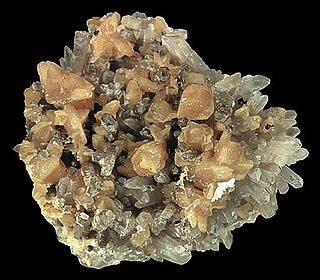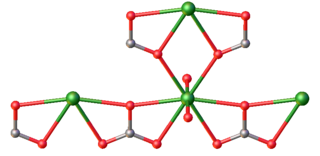Related Research Articles

Gadolinite, sometimes known as ytterbite, is a silicate mineral consisting principally of the silicates of cerium, lanthanum, neodymium, yttrium, beryllium, and iron with the formula (Ce,La,Nd,Y)2FeBe2Si2O10. It is called gadolinite-(Ce) or gadolinite-(Y), depending on the prominent composing element. It may contain 35.5% yttria sub-group rare earths, 2.2% ceria earths, as much as to 11.6% BeO, and traces of thorium. It is found in Sweden, Norway, and the US.

Monazite is a primarily reddish-brown phosphate mineral that contains rare-earth elements. Due to variability in composition, monazite is considered a group of minerals. The most common species of the group is monazite-(Ce), that is, the cerium-dominant member of the group. It occurs usually in small isolated crystals. It has a hardness of 5.0 to 5.5 on the Mohs scale of mineral hardness and is relatively dense, about 4.6 to 5.7 g/cm3. There are five different most common species of monazite, depending on the relative amounts of the rare earth elements in the mineral:

The mineral bastnäsite (or bastnaesite) is one of a family of three carbonate-fluoride minerals, which includes bastnäsite-(Ce) with a formula of (Ce, La)CO3F, bastnäsite-(La) with a formula of (La, Ce)CO3F, and bastnäsite-(Y) with a formula of (Y, Ce)CO3F. Some of the bastnäsites contain OH− instead of F− and receive the name of hydroxylbastnasite. Most bastnäsite is bastnäsite-(Ce), and cerium is by far the most common of the rare earths in this class of minerals. Bastnäsite and the phosphate mineral monazite are the two largest sources of cerium and other rare-earth elements.

Praseodymium is a chemical element; it has symbol Pr and the atomic number 59. It is the third member of the lanthanide series and is considered one of the rare-earth metals. It is a soft, silvery, malleable and ductile metal, valued for its magnetic, electrical, chemical, and optical properties. It is too reactive to be found in native form, and pure praseodymium metal slowly develops a green oxide coating when exposed to air.

Thorianite is a rare thorium oxide mineral, ThO2. It was originally described by Ananda Coomaraswamy in 1904 as uraninite, but recognized as a new species by Wyndham R. Dunstan. It was so named by Dunstan on account of its high percentage of thorium; it also contains the oxides of uranium, lanthanum, cerium, praseodymium and neodymium. Helium is present, and the mineral is slightly less radioactive than pitchblende, but is harder to shield due to its high energy gamma rays. It is common in the alluvial gem-gravels of Sri Lanka, where it occurs mostly as water worn, small, heavy, black, cubic crystals. The largest crystals are usually near 1.5 cm. Larger crystals, up to 6 cm (2.4 in), have been reported from Madagascar.

Abenakiite-(Ce) is a mineral of sodium, cerium, neodymium, lanthanum, praseodymium, thorium, samarium, oxygen, sulfur, carbon, phosphorus, and silicon with a chemical formula Na26Ce6(SiO3)6(PO4)6(CO3)6(S4+O2)O. The silicate groups may be given as the cyclic Si6O18 grouping. The mineral is named after the Abenaki, an Algonquian Indian tribe of New England. Its Mohs scale rating is 4 to 5.
Aeschynite-(Ce) is a rare earth mineral of cerium, calcium, iron, thorium, titanium, niobium, oxygen, and hydrogen with chemical formula (Ce,Ca,Fe,Th)(Ti,Nb)2(O,OH)6. Its name comes from the Greek word αισχύνη ("aeschyne") for "shame" because early chemists had difficulty with separations of titanium from zirconium.
Aeschynite-(Nd) is a rare earth mineral of neodymium, cerium, calcium, thorium, titanium, niobium, oxygen, and hydrogen with the chemical formula (Nd,Ce,Ca,Th)(Ti,Nb)2(O,OH)6. Its name comes from the Greek word for "shame". Its Mohs scale rating is 5 to 6. It is a member of the hydroxide minerals.

Cerite is a complex silicate mineral group containing cerium, formula (Ce,La,Ca)
9(Mg,Fe3+
)(SiO
4)
6(SiO
3OH)(OH)
3. The cerium and lanthanum content varies with the Ce rich species and the La rich species. Analysis of a sample from the Mountain Pass carbonatite gave 35.05% Ce
2O
3 and 30.04% La
2O
3.

Loparite-(Ce) is a granular, brittle oxide mineral of the perovskite class. It is black to dark grey and may appear grey to white in reflected light on polished thin section with reddish brown internal reflections. It has the chemical formula of (Ce,Na,Ca)(Ti,Nb)O3. Nioboloparite is a variation of Loparite-(Ce) containing niobium.

Perovskite (pronunciation: ) is a calcium titanium oxide mineral composed of calcium titanate (chemical formula CaTiO3). Its name is also applied to the class of compounds which have the same type of crystal structure as CaTiO3, known as the perovskite structure, which has a general chemical formula A2+B4+(X2−)3. Many different cations can be embedded in this structure, allowing the development of diverse engineered materials.

Uranyl carbonate refers to the inorganic compound with the formula UO2CO3. Also known by its mineral name rutherfordine, this material consists of uranyl (UO22+) and carbonate (CO32-). Like most uranyl salts, the compound is a polymeric, each uranium(VI) center being bonded to eight O atoms. Hydrolysis products of rutherfordine are also found in both the mineral and organic fractions of coal and its fly ash and is the main component of uranium in mine tailing seepage water.

Cerium is a chemical element; it has symbol Ce and atomic number 58. Cerium is a soft, ductile, and silvery-white metal that tarnishes when exposed to air. Cerium is the second element in the lanthanide series, and while it often shows the oxidation state of +3 characteristic of the series, it also has a stable +4 state that does not oxidize water. It is also considered one of the rare-earth elements. Cerium has no known biological role in humans but is not particularly toxic, except with intense or continued exposure.

Andrianovite is a very rare mineral of the eudialyte group, with formula Na12(K,Sr,Ce)6Ca6(Mn,Fe)3Zr3NbSi(Si3O9)2(Si9O27)2O(O,H2O,OH)5. The original formula was extended to show the presence of cyclic silicate groups and silicon at the M4 site, according to the nomenclature of eudialyte group. Andrianovite is unique among the eudialyte group in being potassium-rich (other eudialyte-group species with essential K are davinciite and rastsvetaevite). It is regarded as potassium analogue of kentbrooksite, but it also differs from it in being oxygen-dominant rather than fluorine-dominant. Also, the coordination number of Na in this representative is enlarged from 7 to 9. The name of the mineral honors Russian mathematician and crystallographer Valerii Ivanovich Andrianov.
Dualite is a very rare and complex mineral of the eudialyte group, its complexity being expressed in its formula Na
30(Ca,Na,Ce,Sr)
12(Na,Mn,Fe,Ti)
6Zr
3Ti
3MnSi
51O
144(OH,H
2O,Cl)
9. The formula is simplified as it does not show the presence of cyclic silicate groups. The name of the mineral comes from its dual nature: zircono- and titanosilicate at once. Dualite has two modules in its structure: alluaivite one and eudialyte one. After alluaivite and labyrinthite it stands for third representative of the eudialyte group with essential titanium.
Oneillite is a rare mineral of the eudialyte group with the chemical formula Na15Ca3Mn3Fe2+3Zr3NbSiO(Si3O9)2(Si9O27)2(O,OH,H2O)3(OH,Cl)2. The formula is based on the original one but extended to show the presence of cyclic silicate groups and domination of Si at the M4 site. The mineral has lowered symmetry (space group R3, instead of more specific for the group R3m one) due to Ca-Mn ordering. Similar feature is displayed by some other eudialyte-group members: aqualite, labyrinthite, raslakite, and voronkovite. Oneillite is strongly enriched in rare earth elements (REE, mainly cerium), but REE do not dominate any of its sites.
Bijvoetite-(Y) is a very rare rare-earth and uranium mineral with the formula (Y,REE)8(UO2)16(CO3)16O8(OH)8·39H2O. When compared to the original description, the formula of bijvoetite-(Y) was changed in the course of crystal structure redefinition. Bijvoetite-(Y) is an example of natural salts containing both uranium and yttrium, the other examples being kamotoite-(Y) and sejkoraite-(Y). Bijvoetite-(Y) comes from Shinkolobwe deposit in Republic of Congo, which is famous for rare uranium minerals. The other interesting rare-earth-bearing uranium mineral, associated with bijvoetite-(Y), is lepersonnite-(Gd).
Florencite-(Sm) is a very rare mineral of the plumbogummite group (alunite supergroup) with simplified formula SmAl3(PO4)2(OH)6. Samarium in florencite-(Sm) is substituted by other rare earth elements, mostly neodymium. It does not form separate crystals, but is found as zones in florencite-(Ce), which is cerium-dominant member of the plumbogummite group. Florencite-(Sm) is also a samarium-analogue of florencite-(La) (lanthanum-dominant) and waylandite (bismuth-dominant), both being aluminium-rich minerals.

Cerianite-(Ce) is a relatively rare oxide mineral, belonging to uraninite group with the formula (Ce,Th)O
2. It is one of a few currently known minerals containing essential tetravalent cerium, the other examples being stetindite and dyrnaesite-(La).
A sulfite sulfate is a chemical compound that contains both sulfite and sulfate anions [SO3]2− [SO4]2−. These compounds were discovered in the 1980s as calcium and rare earth element salts. Minerals in this class were later discovered. Minerals may have sulfite as an essential component, or have it substituted for another anion as in alloriite. The related ions [O3SOSO2]2− and [(O2SO)2SO2]2− may be produced in a reaction between sulfur dioxide and sulfate and exist in the solid form as tetramethyl ammonium salts. They have a significant partial pressure of sulfur dioxide.
References
- ↑ Warr, L.N. (2021). "IMA–CNMNC approved mineral symbols". Mineralogical Magazine. 85 (3): 291–320. Bibcode:2021MinM...85..291W. doi: 10.1180/mgm.2021.43 . S2CID 235729616.
- 1 2 3 4 5 6 Chakhmouradian, A. R., Cooper, M. A., Medici, L., Abdu, Y. A., and Shelukhina, Y. S., 2015. Anzaite-(Ce), a new rare-earth mineral and structure type from the Afrikanda silicocarbonatite, Kola Peninsula, Russia. Mineralogical Magazine 79(5), 1231-1244
- 1 2 3 "Anzaite-(Ce): Anzaite-(Ce) mineral information and data". Mindat.org. Retrieved 2016-03-04.
- ↑ "Lucasite-(Ce): Lucasite-(Ce) mineral information and data". Mindat.org. Retrieved 2016-03-10.